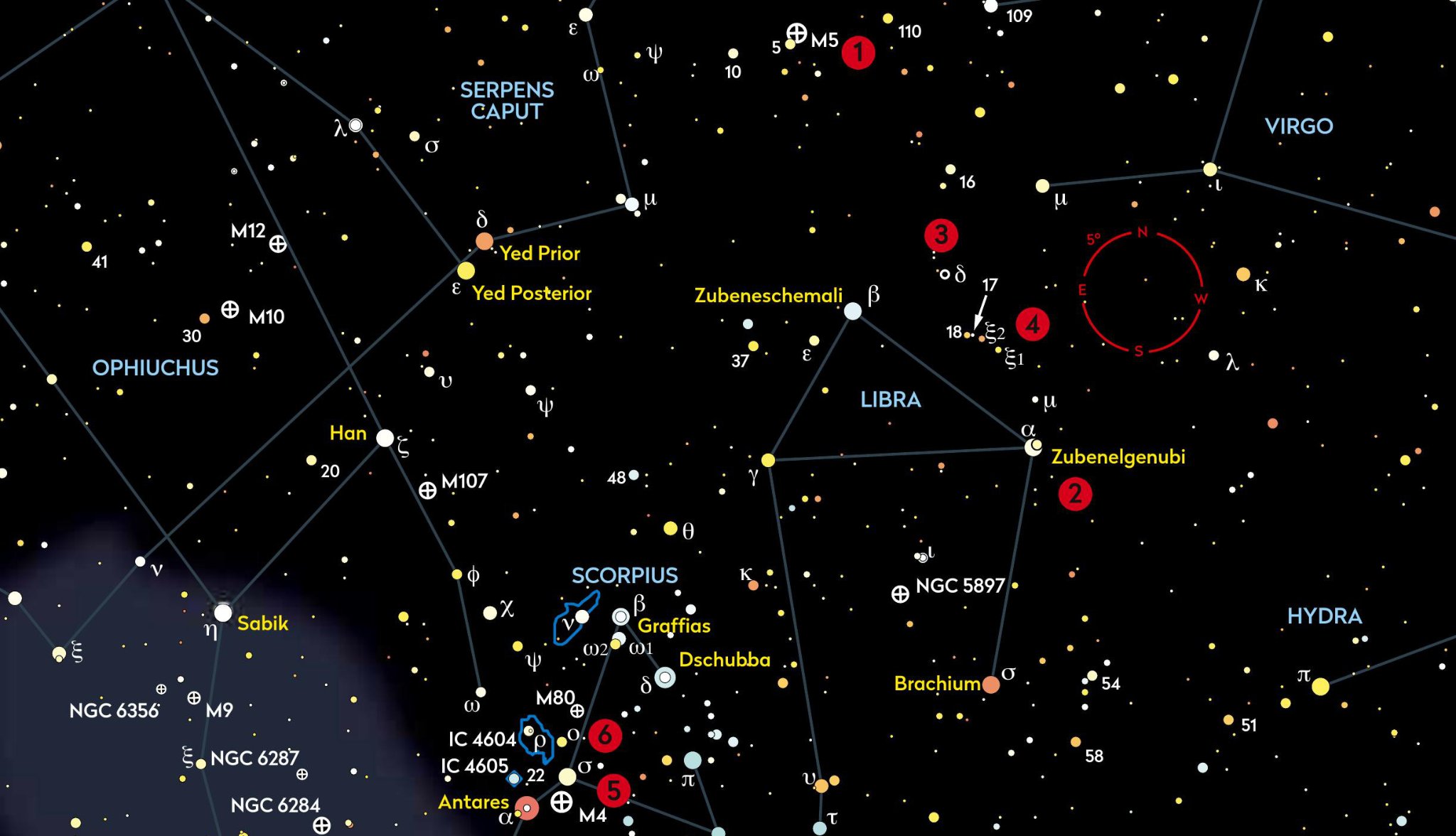Skirt the edge of Libra, the Scales, and take a peek inside the Scorpion’s claws

1. M5
Recommended equipment: 10×50
Let’s start with a fine globular cluster, M5, immediately north-northeast of mag. +5.0 5 Serpentis. It contains mostly Population II stars, which are among the oldest stars that we can see. They are thought to be more than 12 billion years old, which suggests that they formed very soon after our Galaxy did. In 10×50 binoculars, you should notice that M5 brightens towards the centre, exactly like a comet does.
2. Zubenelgenubi
Recommended equipment: 10×50
In antiquity, the stars of Libra, the only non-living zodiac constellation, represented the claws of Scorpius, and the common name of mag. +2.7 Alpha (α) Librae, Zubenelgenubi, means ‘southern claw’ (the northern claw is mag. +2.6 Zubenelschamali (Beta (β) Librae). Zubenelgenubi is a nice easy binocular double star. Binoculars easily reveal the mag. +5.2 companion 3.5 arcminutes away.
3. Delta Librae
Recommended equipment: 10×50
You’ll find the variable (mag. +5.8 to mag. +4.4) Delta (δ) Librae 8° north of Zubenelgenubi. It’s an eclipsing binary star (a pair of stars orbiting their common centre of mass) in which the drop in brightness, which lasts for about six hours, occurs as the dimmer star occults the brighter one. The orbital period is 2.3 days, so even during short summer nights you’ll have several opportunities to notice the magnitude change.
4. Xi1/Xi2 and 17/18 Librae
Recommended equipment: 10×50
Midway between Delta Librae and Zubenelgenubi lie two optical double stars (not gravitationally bound binaries). Mag. +5.8 Xi1 (ξ1) and mag. +5.4 Xi2 (ξ 2) Librae are separated by 0.75°. Half a degree northeast of Xi2 is the other pair, mag. +6.6 17 Librae and mag. +5.8 18 Librae, which are nearly 10 arcminutes apart. There is about 50 lightyears between 17 and 18, and more than four times that between Xi1 and Xi2.
5. M4
Recommended equipment: 15×70
M4 is nearly 1.5° west of bright orange mag. +1.0 Antares (Alpha (α) Scorpii). It is only 7,000 lightyears away, making it appear rather loose, and is one of the few globular clusters in which you may be able to discern some structure with 15×70 binoculars. M4 lies on the edge of the Milky Way, within a beautifully rich, colourful star-field that is more pleasing in binoculars than in a scope.
6. Rho Ophiuchi
Recommended equipment: 10×50
If you navigate 3° north from M4, you’ll find mag. +5.0 Rho (ρ) Ophiuchi. It is the bright component of a triple star, whose seventh-magnitude companions are 2.5 arcminutes to the north and west, respectively. If you have an exceptional southern horizon sky and fancy a challenge, see if averted vision enables you to detect a slight brightening surrounding the star.